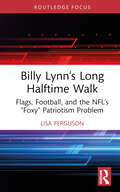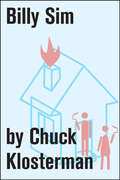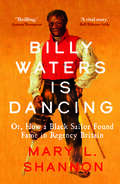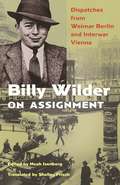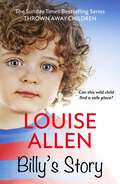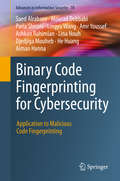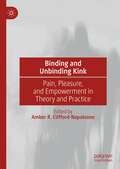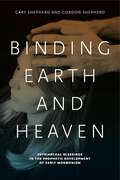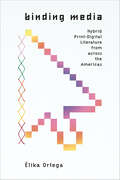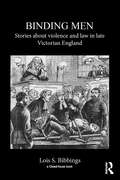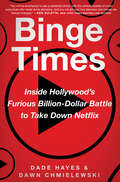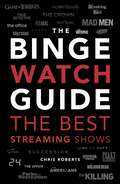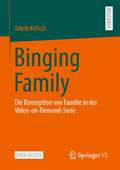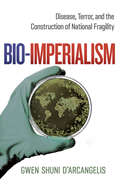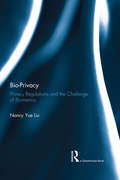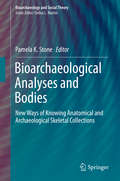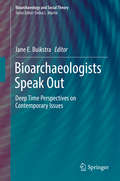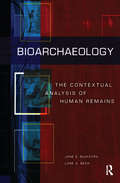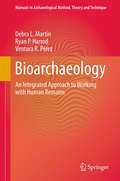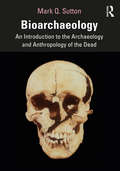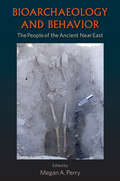- Table View
- List View
Billy Lynn’s Long Halftime Walk: Flags, Football, and the NFL’s “Foxy” Patriotism Problem (Routledge Focus on Literature)
by Lisa FergusonThis book examines how the game of football and militarism have historically overlapped due to their shared celebration of strength, might, and besting a clear and definitive foe. Nevertheless, since September 11, a variety of staged patriotic vignettes dominated most NFL broadcasts, giving the once easy and unforced union a stilted feel. That the War on Terror became a fixture of modern- day Super Bowls was easy to portend; what was more difficult to predict was the imprint it would leave on U.S. citizens and American politics. Ben Fountain’s award- winning novel, Billy Lynn’s Long Halftime Walk, reveals what passes for patriotism in a country that has reduced the sober and stark reality of combat to pageantry and production for the crowd back home, leaving our troops to unwittingly play the part of entertainers, destined to be sexualized just like the cheerleaders and dancers so frequently performing alongside them.
Billy Sim
by Chuck KlostermanOriginally collected in Sex, Drugs, and Cocoa Puffs and now available both as a stand-alone essay and in the ebook collection Chuck Klosterman on Living and Society, this essay is about The Sims.
Billy Waters is Dancing: Or, How a Black Sailor Found Fame in Regency Britain
by Mary L. ShannonThe story of William Waters, Black street performer in Regency London, and how his huge celebrity took on a life of its own Every child in Regency London knew Billy Waters, the celebrated &“King of the Beggars.&” Likely born into enslavement in 1770s New York, he became a Royal Navy sailor. After losing his leg in a fall from the rigging, the talented and irrepressible Waters became London&’s most famous street performer. His extravagantly costumed image blazed across the stage and in print to an unprecedented degree. For all his contemporary renown, Waters died destitute in 1823—but his legend would live on for decades. Mary L. Shannon&’s biography draws together surviving traces of Waters&’ life to bring us closer to the historical figure underlying them. Considering Waters&’ influence on the London stage and his echoing resonances in visual art, and writing by Douglass, Dickens, and Thackeray, Shannon asks us to reconsider Black presences in nineteenth-century popular culture. This is a vital attempt to recover a life from historical obscurity—and a fascinating account of what it meant to find fame in the Regency metropolis.
Billy Wilder on Assignment: Dispatches from Weimar Berlin and Interwar Vienna
by Billy WilderAcclaimed film director Billy Wilder’s early writings—brilliantly translated into English for the first timeBefore Billy Wilder became the screenwriter and director of iconic films like Sunset Boulevard and Some Like It Hot, he worked as a freelance reporter, first in Vienna and then in Weimar Berlin. Billy Wilder on Assignment brings together more than fifty articles, translated into English for the first time, that Wilder (then known as "Billie") published in magazines and newspapers between September 1925 and November 1930. From a humorous account of Wilder's stint as a hired dancing companion in a posh Berlin hotel and his dispatches from the international film scene, to his astute profiles of writers, performers, and political figures, the collection offers fresh insights into the creative mind of one of Hollywood’s most revered writer-directors.Wilder’s early writings—a heady mix of cultural essays, interviews, and reviews—contain the same sparkling wit and intelligence as his later Hollywood screenplays, while also casting light into the dark corners of Vienna and Berlin between the wars. Wilder covered everything: big-city sensations, jazz performances, film and theater openings, dance, photography, and all manner of mass entertainment. And he wrote about the most colorful figures of the day, including Charlie Chaplin, Cornelius Vanderbilt, the Prince of Wales, actor Adolphe Menjou, director Erich von Stroheim, and the Tiller Girls dance troupe. Film historian Noah Isenberg's introduction and commentary place Wilder’s pieces—brilliantly translated by Shelley Frisch—in historical and biographical context, and rare photos capture Wilder and his circle during these formative years.Filled with rich reportage and personal musings, Billy Wilder on Assignment showcases the burgeoning voice of a young journalist who would go on to become a great auteur.
Billy's Story (Thrown Away Children Ser.)
by Louise AllenFrom the bestselling author of the Thrown Away Children series comes another heartbreaking story of life in foster care.Louise has trouble on her hands from the first moment that 5-year-old Billy Blackthorn comes to stay. He is one of more than 20 children taken into care from a single family, and erupts into the Allen household with a volatility that is frightening and disturbing in equal measure. It is only as Louise begins to uncover the secrets of Billy's dark past that she begins to understand what made his family 'untouchable'.'Britain's top foster carer' The Sun'A shining light' Emily Finch, BBC
Billy's Story (Thrown Away Children Ser.)
by Louise AllenFrom the bestselling author of the Thrown Away Children series comes another heartbreaking story of life in foster care.Louise has trouble on her hands from the first moment that 5-year-old Billy Blackthorn comes to stay. He is one of more than 20 children taken into care from a single family, and erupts into the Allen household with a volatility that is frightening and disturbing in equal measure. It is only as Louise begins to uncover the secrets of Billy's dark past that she begins to understand what made his family 'untouchable'.'Britain's top foster carer' The Sun'A shining light' Emily Finch, BBC
Binary Code Fingerprinting for Cybersecurity: Application to Malicious Code Fingerprinting (Advances in Information Security #78)
by He Huang Lingyu Wang Mourad Debbabi Amr Youssef Djedjiga Mouheb Saed Alrabaee Paria Shirani Ashkan Rahimian Lina Nouh Aiman HannaThis book addresses automated software fingerprinting in binary code, especially for cybersecurity applications. The reader will gain a thorough understanding of binary code analysis and several software fingerprinting techniques for cybersecurity applications, such as malware detection, vulnerability analysis, and digital forensics. More specifically, it starts with an overview of binary code analysis and its challenges, and then discusses the existing state-of-the-art approaches and their cybersecurity applications. Furthermore, it discusses and details a set of practical techniques for compiler provenance extraction, library function identification, function fingerprinting, code reuse detection, free open-source software identification, vulnerability search, and authorship attribution. It also illustrates several case studies to demonstrate the efficiency, scalability and accuracy of the above-mentioned proposed techniques and tools. This book also introduces several innovative quantitative and qualitative techniques that synergistically leverage machine learning, program analysis, and software engineering methods to solve binary code fingerprinting problems, which are highly relevant to cybersecurity and digital forensics applications. The above-mentioned techniques are cautiously designed to gain satisfactory levels of efficiency and accuracy. Researchers working in academia, industry and governmental agencies focusing on Cybersecurity will want to purchase this book. Software engineers and advanced-level students studying computer science, computer engineering and software engineering will also want to purchase this book.
Binding and Unbinding Kink: Pain, Pleasure, and Empowerment in Theory and Practice
by Amber R. Clifford-NapoleoneThis book is a collection of essays highlighting different disciplinary, topical, and practical approaches to the study of kink and popular culture. The volume is written by both academics and practitioners, bringing the essays a special perspective not seen in other volumes. Essays included examine everything from Nina Hartley fan letters to kink shibari witches to kink tourism in a South African prison. The focus is not just on kink as a sexual practice, but on kink as a subculture, as a way of living, and as a way of seeing popular culture in new and interesting ways.
Binding Earth and Heaven: Patriarchal Blessings in the Prophetic Development of Early Mormonism
by Gary Shepherd Gordon ShepherdIn Binding Earth and Heaven, Gary Shepherd and Gordon Shepherd use early nineteenth-century Mormonism as a case study to examine questions about how new religious movements may, as rare exceptions, survive and even eventually become successful in spite of intense opposition. Initial scorn and contempt for Mormonism—the fledgling creation of the young Joseph Smith—quickly elevated to mob violence as both Smith’s innovative teachings and converted followers proliferated, resulting in the widely held perception that the Mormons constituted a social menace. This book examines how Mormonism attracted and maintained the loyalty of increasing numbers of people despite mounting hostilities and severe hardships. The book focuses on the unique Mormon ritual (and accompanying doctrinal underpinnings) of “patriarchal blessings.” Patriarchal blessings were an innovative adaptation of the Old Testament practice of fathers making quasi-legal pronouncements over the heads of their sons—a way of verbally conferring rights, promises, admonition, and guidance to heirs. Binding Earth and Heaven shows how the organizational complexities of this practice contributed to strengthening and sustaining member faith and fealty, thereby bolstering the continuity and development of Mormonism.
Binding Earth and Heaven: Patriarchal Blessings in the Prophetic Development of Early Mormonism
by Gary Shepherd Gordon ShepherdIn Binding Earth and Heaven, Gary Shepherd and Gordon Shepherd use early nineteenth-century Mormonism as a case study to examine questions about how new religious movements may, as rare exceptions, survive and even eventually become successful in spite of intense opposition. Initial scorn and contempt for Mormonism—the fledgling creation of the young Joseph Smith—quickly elevated to mob violence as both Smith’s innovative teachings and converted followers proliferated, resulting in the widely held perception that the Mormons constituted a social menace. This book examines how Mormonism attracted and maintained the loyalty of increasing numbers of people despite mounting hostilities and severe hardships. The book focuses on the unique Mormon ritual (and accompanying doctrinal underpinnings) of “patriarchal blessings.” Patriarchal blessings were an innovative adaptation of the Old Testament practice of fathers making quasi-legal pronouncements over the heads of their sons—a way of verbally conferring rights, promises, admonition, and guidance to heirs. Binding Earth and Heaven shows how the organizational complexities of this practice contributed to strengthening and sustaining member faith and fealty, thereby bolstering the continuity and development of Mormonism.
Binding Media: Hybrid Print-Digital Literature from across the Americas (Stanford Text Technologies)
by Élika OrtegaFar from causing the "death of the book," the publishing industry's adoption of digital technologies has generated a multitude of new works that push the boundaries of literature and its presentation. In this fascinating new work, Élika Ortega proposes the notion of "binding media" — a practice where authors and publishers "fasten together" a codex and electronic or digital media to create literary works in the form of hybrid print-digital objects. Examining more than a hundred literary works from across the Americas, Ortega argues that binding media are not simply experimentations but a unique contemporary form of the book that effectively challenges conventional regional and linguistic boundaries. Furthermore, the book demonstrates that binding media have remained marginal in the publishing industry due to technological imperatives like planned obsolescence and commercial ones like replicability and standardization that run counter to these bespoke literary projects. Although many binding media and other hybrid publishing initiatives have perished, they've left behind a wealth of material; collecting and tracing the residues of these foreshortened projects, Ortega builds a fascinating history of hybrid publishing. Ultimately, this essential account of contemporary book history highlights the way binding media help illuminate processes of cultural hybridization that have been instigated by the expediency of globalized digital technologies and transnational dynamics.
Binding Men: Stories About Violence and Law in Late Victorian England
by Lois S. BibbingsBinding Men tells stories about men, violence and law in late Victorian England. It does so by focusing upon five important legal cases, all of which were binding not only upon the males involved but also upon future courts and the men who appeared before them. The subject matter of Prince (1875), Coney (1882), Dudley and Stephens (1884), Clarence (1888) and Jackson (1891) ranged from child abduction, prize-fighting, murder and cannibalism to transmitting gonorrhoea and the capture and imprisonment of a wife by her husband. Each case has its own chapter, depicting the events which led the protagonists into the courtroom, the legal outcome and the judicial pronouncements made to justify this, as well as exploring the broader setting in which the proceedings took place. In so doing, Binding Men describes how a particular case can be seen as being a part of attempts to legally limit male behaviour. The book is essential reading for scholars and students of crime, criminal law, violence, and gender. It will be of interest to those working on the use of narrative in academic writing as well as legal methods. Binding Men’s subject matter and accessible style also make it a must for those with a general interest in crime, history and, in particular, male criminality.
Binge Times: Inside Hollywood's Furious Billion-Dollar Battle to Take Down Netflix
by Dade Hayes Dawn ChmielewskiThe first comprehensive account of the biggest wake-up call in the history of the entertainment business: the pivot to streaming. Go inside a disparate group of media and tech companies -- Disney, Apple, AT&T/WarnerMedia, Comcast/NBCUniversal and well-funded startup Quibi – as they scramble to mount multi-billion-dollar challenges to Netflix.After spotting Netflix and the deep-pocketed Amazon Prime Video a decade’s head start, rivals from the tech and start-up realm (Apple, Quibi) and traditional media (Disney, WarnerMedia, NBCUniversal) all decided to move mountains to enter the streaming game. At a cost of billions, each went after their own piece of the market, launching five new services in a seven-month span. And just as the derby was heating up, the coronavirus pandemic arrived, a black-swan event bringing short-term benefits but also stiff challenges.The battle for streaming supremacy may end up having more than one winner, but the cost and disruption to decades-old business models have also produced a lot of losers. Binge Times reveals the true costs of the vision quest as companies are turned inside-out and repeatedly redraw their org charts and strategic plans. Stretching from Silicon Valley to Hollywood to Wall Street, it is a mesmerizing, character-rich tale of hubris and ambition, as the fate of a century-old industry hangs in the balance.
The Binge Watch Guide: The best television and streaming shows reviewed
by Chris RobertsThe 100 best streaming shows reviewed and rated. You may have viewing time on your hands – this guide will give you ideas for what to watch next, with reviews of more than 100 of the best shows around, from the BBC, ITV, C4, HBO, Amazon Prime, Sky Atlantic, Netflix, Disney+ and more.From The Affair to The X-Files, Fawlty Towers to Fleabag, Parks and Recreation to Peaky Blinders and from Game of Thrones to The Crown.
Binging Family: Die Konzeption von Familie in der Video-on-Demand-Serie
by Jakob KelschIn diesem Open-Access-Buch zeigt Jakob Kelsch, wie sich in der US-amerikanischen TV-Serie der 1950er und 1960er Jahre der Mythos der patriarchal-strukturierten Kernfamilie als Ideal des familiären Zusammenlebens herausbildete. Trotz Phasen der Dekonstruktion und der zunehmenden Repräsentation problematischer und ethnisch wie sozial diverser Familienverhältnisse erweist sich dieser Mythos bis heute als äußerst persistent. Der durch den Digitalisierungsprozess bedingte Aufstieg der Streamingdienste und der Siegeszug deren serieller Erzeugnisse brachte eine inhaltliche Diversifizierung des Genres Familienserie und eine zunehmende narrative Komplexität mit sich. Doch auch diese kann nur an der Oberfläche des tief im kulturellen Wissen verankerten Mythos der heteronormativen Kernfamilie rütteln.
Bio-Imperialism: Disease, Terror, and the Construction of National Fragility
by Gwen Shuni D'ArcangelisBio-Imperialism focuses on an understudied dimension of the war on terror: the fight against bioterrorism. This component of the war enlisted the biosciences and public health fields to build up the U.S. biodefense industry and U.S. global disease control. The book argues that U.S. imperial ambitions drove these shifts in focus, aided by gendered and racialized discourses on terrorism, disease, and science. These narratives helped rationalize American research expansion into dangerous germs and bioweapons in the name of biodefense and bolstered the U.S. rationale for increased interference in the disease control decisions of Global South nations. Bio-Imperialism is a sobering look at how the war on terror impacted the world in ways that we are only just starting to grapple with.
Bio-Privacy: Privacy Regulations and the Challenge of Biometrics
by Nancy Yue LiuBio-Privacy: Privacy Regulations and the Challenge of Biometrics provides an in-depth consideration of the legal issues posed by the use of biometric technology. Focusing particularly on the relationship between the use of this technology and the protection of privacy, this book draws on material across a range of jurisdictions in order to explore several key questions. What are the privacy issues in the biometric context? How are these issues currently dealt with under the law? What principles are applied? Is the current regulation satisfactory? Is it applied consistently? And, more generally, what is the most appropriate way to deal with the legal implications of biometrics? Offering an analysis, and recommendations, with a view to securing adequate human rights and personal data protection, Bio-Privacy: Privacy Regulations and the Challenge of Biometrics will be an important reference point for those with interests in the tension between freedom and security.
Bioarchaeological Analyses and Bodies: New Ways of Knowing Anatomical and Archaeological Skeletal Collections (Bioarchaeology and Social Theory)
by Pamela K. StoneThis volume features bioarchaeological research that interrogates the human skeleton in concert with material culture, ethnographic data and archival research. This approach provides examples of how these intersections of inquiry can be used to consider the larger social and political contexts in which people lived and the manner in which they died. Bioarchaeologists are in a unique position to develop rich interpretations of the lived experiences of skeletonized individuals. Using their skills in multiple contexts, bioarchaeologists are also situated to consider the ethical nature and inherent humanity of the research collections that have been used because they represent deceased for whom there are records identifying them. These collections have been the basis for generating basic information regarding the human skeletal transcript. Ironically though, these collections themselves have not been studied with the same degree of understanding and interpretation that is applied to archaeological collections.
Bioarchaeological and Forensic Perspectives on Violence
by Debra L. Martin Cheryl P. AndersonEvery year, there are over 1. 6 million violent deaths worldwide, making violence one of the leading public health issues of our time. And with the 20th century just behind us, it's hard to forget that 191 million people lost their lives directly or indirectly through conflict. This collection of engaging case studies on violence and violent deaths reveals how violence is reconstructed from skeletal and contextual information. By sharing the complex methodologies for gleaning scientific data from human remains and the context they are found in, and complementary perspectives for examining violence from both past and contemporary societies, bioarchaeology and forensic anthropology prove to be fundamentally inseparable. This book provides a model for training forensic anthropologists and bioarchaeologists, not just in the fundamentals of excavation and skeletal analysis, but in all subfields of anthropology, to broaden their theoretical and practical approach to dealing with everyday violence.
Bioarchaeologists Speak Out: Deep Time Perspectives on Contemporary Issues (Bioarchaeology and Social Theory)
by Jane E. BuikstraBioarchaeologists who study human remains in ancient, historic and contemporary settings are securely anchored within anthropology as anthropologists, yet they have not taken on the pundits the way other subdisciplines within anthropology have. Popular science authors frequently and selectively use bioarchaeological data on demography, disease, violence, migration and diet to buttress their poorly formed arguments about general trends in human behavior and health, beginning with our earliest ancestors. While bioarchaeologists are experts on these subjects, bioarchaeology and bioarchaeological approaches have largely remained invisible to the public eye. Current issues such as climate change, droughts, warfare, violence, famine, and the effects of disease are media mainstays and are subjects familiar to bioarchaeologists, many of whom have empirical data and informed viewpoints, both for topical exploration and also for predictions based on human behavior in deep time. The contributions in this volume will explore the how and where the data has been misused, present new ways of using evidence in the service of making new discoveries, and demonstrate ways that our long term interdisciplinarity lends itself to transdisciplinary wisdom. We also consider possible reasons for bioarchaeological invisibility and offer advice concerning the absolute necessity of bioarchaeologists speaking out through social media.
Bioarchaeology: The Contextual Analysis of Human Remains (Bioarchaeology And Social Theory Ser.)
by Jane E. Buikstra Lane A. BeckThe core subject matter of bioarchaeology is the lives of past peoples, interpreted anthropologically. Human remains, contextualized archaeologically and historically, form the unit of study. Integrative and frequently inter-disciplinary, bioarchaeology draws methods and theoretical perspectives from across the sciences and the humanities. Bioarchaeology: The Contextual Study of Human Remains focuses upon the contemporary practice of bioarchaeology in North American contexts, its accomplishments and challenges. Appendixes, a glossary and 150 page bibliography make the volume extremely useful for research and teaching.
Bioarchaeology
by Clark Spencer LarsenThese important essays address the biological consequences of the arrival of Europeans in the New World and on the lifeways of native populations following contact in the late 16th century. Moving away from monocausal explanations of population change, they maintain that disease should be viewed as only a facet of a complex problem and that issues relating to diet, nutrition, activity, the work environment, and social and political change are equally important.
Bioarchaeology: An Integrated Approach to Working with Human Remains (Manuals in Archaeological Method, Theory and Technique #6)
by Ventura R. Pérez Debra L. Martin Ryan P. HarrodBioarchaeology is the analysis of human remains within an interpretative framework, including a wide range of contextual information. This comprehensive and much-needed manual provides both a starting point and a reference for archaeologists working in this integrative field. The authors cover a range of bioarchaeological methods and theory including: · Ethical issues involved in dealing with human remains, specifically related to NAGPRA · Field and taphonomic clues · Lab and Forensic techniques · Best practices methods for Excavation techniques · Special applications of Bioarchaeology · Theoretical frameworks of Bioarchaeology With case studies from over twenty years each of bioarchaeological research, the authors integrate theoretical and methodological discussion with a wide range of field studies, from different geographic areas, time periods, and data types, to demonstrate the full scope of this important field of study.
Bioarchaeology: An Introduction to the Archaeology and Anthropology of the Dead
by Mark Q. SuttonBioarchaeology covers the history and general theory of the field plus the recovery and laboratory treatment of human remains. Bioarchaeology is the study of human remains in context from an archaeological and anthropological perspective. The book explores, through numerous case studies, how the ways a society deals with their dead can reveal a great deal about that society, including its religious, political, economic, and social organizations. It details recovery methods and how, once recovered, human remains can be analyzed to reveal details about the funerary system of the subject society and inform on a variety of other issues, such as health, demography, disease, workloads, mobility, sex and gender, and migration. Finally, the book highlights how bioarchaeological techniques can be used in contemporary forensic settings and in investigations of genocide and war crimes. In Bioarchaeology, theories, principles, and scientific techniques are laid out in a clear, understandable way, and students of archaeology at undergraduate and graduate levels will find this an excellent guide to the field.
Bioarchaeology and Behavior: The People of the Ancient Near East (Bioarchaeological Interpretations of the Human Past: Local, Regional, and Global)
by Megan A. PerryWhile mortuary ruins have long fascinated archaeologists and art historians interested in the cultures of the Near East and eastern Mediterranean, the human skeletal remains contained in the tombs of this region have garnered less attention. In Bioarchaeology and Behavior, Megan Perry presents a collection of essays that aim a spotlight on the investigation of the ancient inhabitants of the circum-Mediterranean area.Composed of eight diverse papers, this volume synthesizes recent research on human skeletal remains and their archaeological and historical contexts in this region. Utilizing an environmental, social, and political framework, the contributors present scholarly case studies on such topics as the region’s mortuary archaeology, genetic investigations of migration patterns, and the ancient populations’ health, disease, and diet. Other key anthropological issues addressed in this volume include the effects of the domestication of plants and animals, the rise of state-level formations, and the role of religion in society. Ultimately, this collection will provide anthropologists, archaeologists, and bioarchaeologists with an important foundation for future research in the Near East and eastern Mediterranean.
